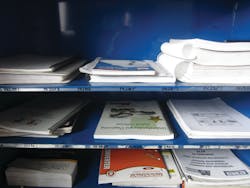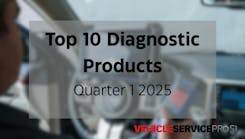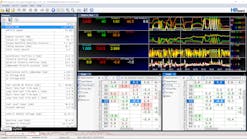Tool Q&A: Need-to-know information
Q: Why can't I just use Google for everything? Service information is expensive!
A: Google links to some good websites, such as iATN, but the vast majority of information out there is from DIYers for DIYers and not fit for professional use. To be honest, the online forums where DIYers give uninformed opinions on everything from their check engine lights to doing their own timing chain, because they are too cheap to pay a professional, can be problematic. These guys love giving opinions, but don't have a clue about what they're doing.
The one exception to this perhaps is Youtube where there are channels where professional technicians upload how to do something highly technical, such as replacing rear air springs on a 2004 Mercedes E500. Now, if you were to use an "enthusiast" forum in place of technical information, you might find a DIYer avoiding dropping down the whole exhaust and rear end and not use a scan tool to fill the bags back up when replacing them. The result? Those particular air springs like to pinch internally. It's not good to take advice from someone who has very low expectations for his work, because if he fails, he has no one to get mad at besides himself. And, human nature dictates that we're never to blame for our own faults, right?
So, get information from professionals for professionals. And, that means getting a professional repair database from a mainstream company.
Q: I can't decide which repair database I want. Help!
A: Choosing between the several databases out there such as AllData, Autodata, Chilton, Identifix and Mitchell 1, is a common problem. All of these systems provide the vast majority of what you need for the majority of vehicles. So, how do you decide which one to get?
Now, this might not apply to every single vehicle in either system, but the following facts generally apply. Mitchell 1's ProDemand has color-coded wiring diagrams that can be manipulated (Figs. 1 to 3) to make them easier to read while AllData has OEM wiring diagrams (Fig. 4,) because that information system emphasizes more complete OEM data. There might be situations where you need the 100 percent accuracy of OE information while other times, it slows you down and it would be preferable to see a more complete, color-coded wiring diagram you can manipulate.
Oftentimes, AllData will have something Mitchell 1 does not have on a certain vehicle and vice versa. Another important tidbit of information about these systems is that if you specialize in European vehicles, you will probably need to supplement either of these databases with OEM information.
Autodata's Quick Reference Pro is an information system that combines easy to use wiring diagrams (like ProDemand's) with OE information (like AllData), but also includes a quick reference to relearning keys, batteries and more. The system also includes labor times, service schedules, TSBs separated by topic, quick torque and fluid specifications reference and timing chain instructions, which can be real handy. (See Fig. 5.)
Chilton Pro also deserves mention because it works very much like AllData, and because it employs the use of factory wiring diagrams and information. Repair information is modified and edited to make it simpler to read and torque specs are inserted right into the repair procedures. Translating Nm to ft/lbs is a plus. It is also the least expensive of the mainstream repair databases. This may be seen as a benefit to some shops, but the opposite to others looking for a system which has even more information. (See Fig. 6.)
Regardless of the respective strengths and weaknesses of each program, you are better off with a combination of these programs rather than just one. The more information you have to fix a car, the better.
Q: I already have an information system that I pay good money for. Do I really need to buy more information?
A: Yes, and for a couple of reasons. You might need specific information fast or simply more information. (See Fig. 7.)
In the real world, you might need to look up information on everything from running monitors to relearns after replacing a battery. Oftentimes service information, reset information, battery coding, resetting TPMS systems and more are either very hard to get from or not in your repair database. So, companies like Motor Information Systems and Autodata, amongst others, do the sifting through OEM information for you and provide information in an easy-to-digest package. In a business with small margins on batteries, oil changes and tires, the quicker you can get your hands on this information, the better.
"The more information, the better" applies as well. As you can see in the picture of a regular shop computer, sometimes we just need information from a lot of places. What ProDemand does not have AllData has, what AllData does not have Identifix OEM Direct has, what Identifix lacks Autodata Quick Reference Pro might have and etcetera. If you are a shop that charges a good price for diagnostics, you will need as many information sources as possible.
Q: How should I use Identifix other than looking at pattern failures?
A: Identifix Direct-Hit has a wealth of information. This includes short test procedures with specifications that are a replacement for test plans that a factory scan tool might have, OEM information for select manufacturers and relatively up-to-date TSBs. The OEM information is "searchable," as is everything else in Identifix. This is an extremely useful feature of this database, as it helps increase the speed of your diagnosis.
Q: Sometimes we simply cannot look up everything we need to diagnose a car. Is there something we're missing?
A: Yes, sometimes we need more than specifications and repair procedures. A database cannot teach you how to think.
This is where training comes in. Your local parts store might offer classes or you might be aware of a national training event (i.e., VISION), vehicle-specific training offered in a nearby city (often Worldpac), or full seminars online (Technicians Service Training). Whatever training you do get, it's best that you get the training that is applicable to you. Hands-on training might benefit you the most, for example. Oftentimes, a little bit of training goes a long way in helping you ask the right questions and look for the right things from your repair databases, but we'll cover this in more detail in a future Q&A.
Have questions? Need answers? Email [email protected] to have your questions answered in this column.


